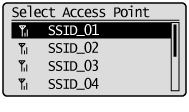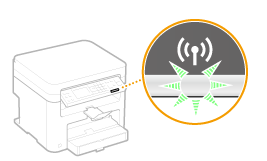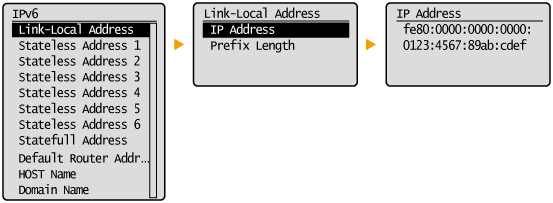Setting the Wireless LAN Manually (MF212w Only)
22-Sep-2014
8202247300
Solution
After you decide wireless LAN to connect the machine to the computer, select wireless LAN using the operation panel. Note that if you change the setting from <Wired LAN> to <Wireless LAN> or vice versa, you will need to uninstall MF Drivers installed on your computer and then reinstall them.
1. Press  .
.
 .
.2. Use  /
/  to select <Network Settings>, and press
to select <Network Settings>, and press  .
.
 /
/  to select <Network Settings>, and press
to select <Network Settings>, and press  .
.- If a screen for entering a PIN is displayed, enter the PIN with the numeric keys and press
 .
.
3. Select <Select Wired/Wireless LAN> and press  .
.
 .
.4. Select <Wireless LAN> and press  .
.
 .
.
5. Press  .
.
 .
.You can search the wireless routers (or access points) available for connection and select one from the display of the machine. For the network key, enter a WEP key or TKIP. Before selecting a wireless router, check and write down the required setup information, including the SSID and network key [ Checking the Access Point Name or Network Key (MF212w Only) ].
NOTE
Security settings
- If the wireless connection is set up by selecting a wireless router, the WEP authentication method is set to <Open System> or the WPA/WPA2 encryption method is set to <Auto> (AES-CCMP or TKIP). If you want to select <Shared Key> for WEP authentication or <AES-CCMP> for WPA/WPA2 encryption, you need to set up the connection using the manual entry method.
1.Press  .
.
 .
.2. Use  /
/  to select <Network Settings>, and press
to select <Network Settings>, and press  .
.
 /
/  to select <Network Settings>, and press
to select <Network Settings>, and press  .
.- If a screen for entering a PIN is displayed, enter the PIN with the numeric keys and press
 .
.
3. Select <Wireless LAN Settings> and press  .
.
 .
.- If the <Enable the wireless LAN?> message is displayed, select <Yes>, and press
 .
.
4. Read the message that is displayed and press  .
.
 .
.5. Select <SSID Settings> and press  .
.
 .
.
6. Select <Select Access Point> and press  .
.
 .
.- The machine starts searching for available wireless routers.


If <Cannot find the access point.> is displayed. For details , see the "e-Manual" (HTML manual) in the DVD-ROM supplied with the machine.
7. Select a wireless LAN router and press  .
.
 .
.- Select the router whose SSID matches the one that you have written down.


- If your wireless router is not found, See Getting started.
8. Enter the network key that you have written down.
- Enter the network key using the numeric keys, select <Apply>, and press
 .
.
- WEP

- WPA-PSK or WPA2-PSK

9. Select <Yes> and press  .
.
 .
.

If an error message is displayed during setup
- Press
 , check whether the network key is correct, and return to step 5.
, check whether the network key is correct, and return to step 5.
10. Check that the Wi-Fi indicator is blinking on the operation panel.
- The Wi-Fi indicator blinks when a wireless router is detected.

- When the setup is completed, the screen below is displayed, and approximately 2 seconds later, the Wi-Fi indicator lights up.

- Wait approximately 2 minutes until the IP address settings of the machine are completed.

Signal strength
- When more than one wireless router is available for connection, the machine connects to the device with the strongest signal. Signal strength is measured using RSSI (Received Signal Strength Indication).
NOTE
Reducing power consumption
- You can set the machine to enter <Power Save Mode> based on signals emitted from the wireless router.
If the IP address of the machine has changed
- In a DHCP environment, the IP address of the machine may be changed automatically. If this happens, the connection is maintained as long as the machine and the computer belong to the same subnet.
If you want to specify the security settings in detail or cannot establish the wireless connection using the other procedures, manually enter all the required information for the wireless LAN connection. Before specifying detailed settings, check and write down the required information, including the SSID, network key, and wireless security protocols. [ Checking the Access Point Name or Network Key (MF212w Only) ]
1. Press  .
.
 .
.2. Use  /
/  to select <Network Settings>, and press
to select <Network Settings>, and press  .
.
 /
/  to select <Network Settings>, and press
to select <Network Settings>, and press  .
.- If a screen for entering a PIN is displayed, enter the PIN with the numeric keys and press
 .
.
3. Select <Wireless LAN Settings> and press  .
.
 .
.- If the <Enable the wireless LAN?> message is displayed, select <Yes>, and press
 .
.
4. Read the message that is displayed and press  .
.
 .
.5. Select <SSID Settings>  <Enter Manually>.
<Enter Manually>.
 <Enter Manually>.
<Enter Manually>.6. Enter the SSID that you have written down.
- Enter the SSID using the numeric keys, select <Apply>, and press
 .
.

7. Specify the security settings based on the information that you have written down.
- If you do not need to specify the security settings, select <None> and press
 .
.

 Using WEP
Using WEP7-A-1. Select <WEP> and press  .
.
 .
.7-A-2. Select an authentication method and press  .
.
 .
.
 <Open System>
<Open System>Sets open system authentication, which is also called "open authentication."
 <Shared Key>
<Shared Key>Uses the WEP key as a password.

When <Open System> is selected
- When connecting to a wireless LAN, the machine experiences an authentication error if the shared key authentication is set on the wireless router. If this happens, the machine automatically changes the setting to <Shared Key> and retries the connection.
7-A-3. Select <Edit WEP Key> and press  .
.
 .
.
7-A-4. Select the WEP key that you want to edit, and press  .
.
 .
.- Up to four WEP keys can be registered.

7-A-5. Enter the network key that you have written down.
- Enter the network key using the numeric keys and select <Apply>, and press
 .
.

7-A-6. Select <Select WEP Key> and press  .
.
 .
.7-A-7. Select the WEP key you have edited, and press  .
.
 .
. Using WPA-PSK or WPA2-PSK
Using WPA-PSK or WPA2-PSK7-B-1. Select <WPA/WPA2-PSK> and press  .
.
 .
.7-B-2. Select an encryption method and press  .
.
 .
.
 <Auto>
<Auto>Sets the machine to automatically select AES-CCMP or TKIP to match the setting of the wireless router.
 <AES-CCMP>
<AES-CCMP>Sets AES-CCMP as the encryption method.
7-3. Enter the network key that you have written down.
- Enter the network key using the numeric keys and press <Apply>, and press
 .
.

8. Select <Yes> and press  .
.
 .
.

If an error message is displayed during setup
- Press
 , check whether the specified settings are correct, and return to step 5.
, check whether the specified settings are correct, and return to step 5.
9. Check that the Wi-Fi indicator is blinking on the operation panel.
- The Wi-Fi indicator blinks when a wireless router is detected.

- When the setup is completed, the screen below is displayed, and approximately 2 seconds later, the Wi-Fi indicator lights up.

- Wait approximately 2 minutes until the IP address settings of the machine are completed.

Signal strength
- When more than one wireless router is available for connection, the machine connects to the device with the strongest signal. Signal strength is measured using RSSI (Received Signal Strength Indication).
NOTE
Reducing power consumption
- You can set the machine to enter <Power Save Mode> based on signals emitted from the wireless router.
If the IP address of the machine has changed
- In a DHCP environment, the IP address of the machine may be changed automatically. If this happens, the connection is maintained as long as the machine and the computer belong to the same subnet
NOTE
- The IP address is not correctly configured if it is displayed as "0.0.0.0".
- Connecting the machine to a switching hub or bridge may result in a connection failure even when the IP address is correctly configured. This problem can be solved by setting a certain interval before the machine starts communicating.
Setting a Wait Time for Connecting to a Network
- You can print a list of the current network settings.
 Viewing IPv4 Settings
Viewing IPv4 Settings

 <Network Information>
<Network Information> 



 <IPv4>
<IPv4> 



 Select the setting to view
Select the setting to view 



 Viewing IPv6 Settings
Viewing IPv6 Settings

 <Network Information>
<Network Information> 



 <IPv6>
<IPv6> 



 Select the setting to view
Select the setting to view 


